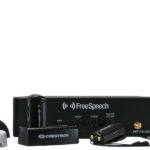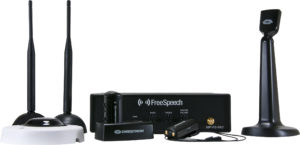
Innovative new speakers, public address systems, and sound amplification systems that make it easy to set up and control the audio in classrooms and other locations were among the many audio-visual products highlighted at InfoComm 2011 in Orlando last month.
For instance, Outline North America demonstrated its Mini COM.P.A.S.S. line of portable speakers. COM.P.A.S.S. stands for “Compact Polar Adjustable Sound System,” and these speakers are stackable, networkable, and fully adjustable. Each speaker contains a digital signal processor, and the bellows move in a range from 60 degrees to 150 degrees—allowing users to steer the sound away from a wall and control where the signal goes with remarkable precision.
At InfoComm 2011, Outline also debuted a new browser-based application that lets users manage the Mini COM.P.A.S.S. speakers from an iPhone, iPad, laptop, or other mobile device. The app lets you control the volume, delay, bass, and treble of each individual speaker, and you can control the angle each speaker is set to as well. When you click on a designated speaker in the application, the speaker itself lights up, so you easily can see which device you’re controlling in a line array.
Peavey Electronics demonstrated several portable PA systems that are useful for setting up audio for outdoor events, or in places that don’t have a full sound system. They range from the $299 Messenger system, which provides “audio in a box,” to the TriFlex system for under $800.
The Messenger system is contained in a suitcase-size carrying case. Its top tilts up and can be used as a lectern by the presenter. It puts out 100 watts of sound through up to four audio channels. The TriFlex system, which generated a great deal of interest at InfoComm 2011, consists of an amplifier on wheels and two raised speakers on tripods.
Last year, the Federal Communications Commission ruled that schools, colleges, and others using wireless microphones operating on the 700 megahertz (MHz) frequency band must change the radio frequency or buy new equipment. The FCC’s decision was part of a larger effort to clear the 700 MHz band for use by cell phones, digital TV transmissions, and emergency communications—but it also affected many schools.
At InfoComm, Califone demonstrated a wireless PA upgrade kit intended to help schools and colleges still operating on the 700 MHz frequency band move to the 900 MHz band without a costly investment in new equipment. At $350, the product also can be used as an assistive listening system or to make a wired PA system wireless, said Tim Ridgway, vice president of marketing for Califone.
Extron Electronics unveiled new classroom speakers with grooved channels on the back, allowing them to slide easily on or off a fixed wall mount. This design allows schools to swap out individual speakers as necessary, avoiding the need for a costly upgrade, Extron said. The speakers also include an anti-theft mechanism to keep them from being stolen.
In addition, both Extron and Panasonic demonstrated products that build security into wireless microphones used for classroom instruction.
At last year’s InfoComm, Panasonic introduced the first wireless microphone that combines classroom audio and emergency alert in a single system. The Panasonic Security Alert system features a button on a microphone worn around the instructor’s neck that, when pressed, sends a silent alarm to school administrators. Once alerted, school leaders have access to a live video feed courtesy of a networked camera inside the classroom, as well as to the audio feed captured on the microphone—so they can immediately monitor the emergency that is unfolding.
During InfoComm 2011, Panasonic demonstrated the latest advancements to the system, which uses IP cameras made by the company. The cameras—which also can be used for lecture capture and review—can be controlled via a touch-screen interface that lets authorized users pan, tilt, and zoom from within any internet browser.
A new security system in Extron’s VoiceLift microphone system gives educators many of the same capabilities, but with a key difference: Schools don’t have to use cameras made by a specific manufacturer, Extron said.
Crestron’s FreeSpeech wireless microphone system also includes a panic button, which sends an emergency alert to the company’s RoomView AV controller software—but it adds another innovation designed to save instructors from potential embarrassment.
The microphone uses both radio frequency (RF) and infrared (IR) technology to connect with a receiver. The sound waves travel via RF technology, but the IR connection exists so that if an instructor leaves the room—say, to use the bathroom—but he or she forgets to turn off the mic, the device no longer will broadcast.
- Extron AV Switching, Streaming, and Control Systems Aid Higher Learning at Idaho’s First Medical School - June 1, 2021
- Extron XTP, Streaming, and Control Systems Empower Point Park University’s Varsity Esports Program - June 1, 2021
- Extron NAV Series Delivers AVoIP Throughout Allied Health Veterans Hall at UNC Wilmington - June 1, 2021

